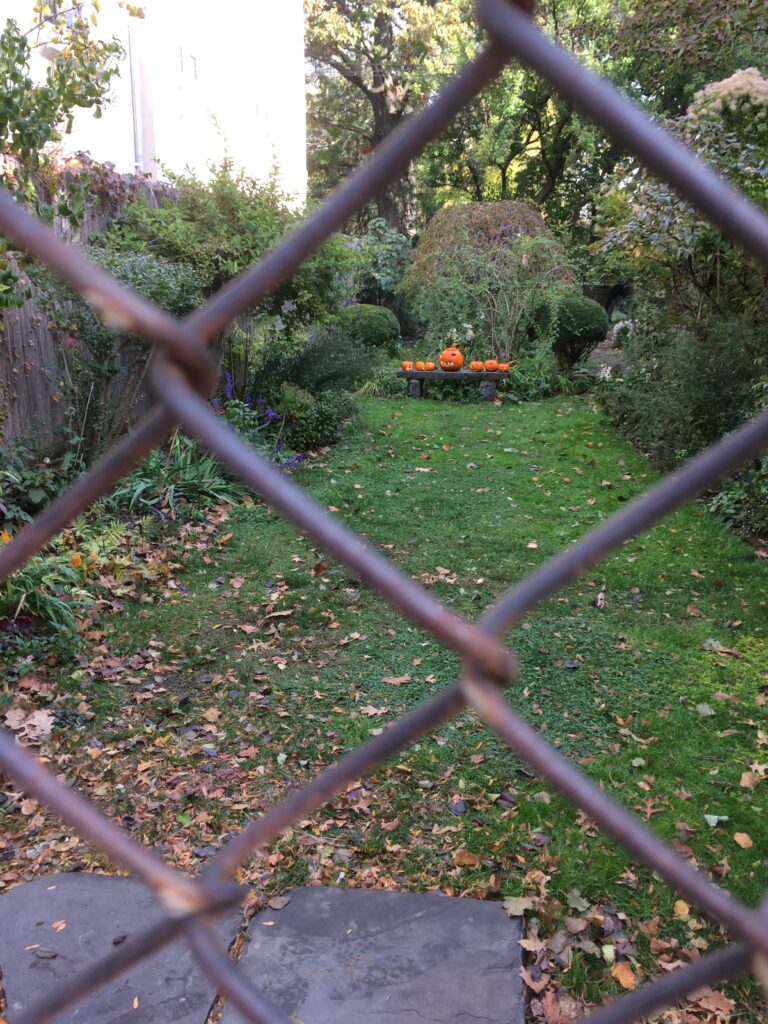
GOD Almightie first Planted a Garden. And indeed, it is the Purest of Humane pleasures. It is the Greatest Refreshment to the Spirits of Man; Without which, Buildings and Pallaces are but Grosse Handy-works.
—Francis Bacon, from his 1625 essay, “Of Gardens”
I open the garden on the morning of November 4, after sixteen hours of poll work the day before, sure Trump will be re-elected. The lawn is scattered with red and yellow leaves. The late roses are wan and bedraggled as chiffon ballgowns after a hard night of dancing. Shocking purple aconitum are the finale—their hood-shaped blossoms (hence their popular name, monk’s hood) visible from fifty feet away. The twisted apricot tree is filled with warblers; this English garden in Brooklyn makes a classy pit stop on their way to Guatemala.
A young couple, seeing the chain-link gate ajar, peers in. “You’re welcome,” I say. They enter, reverent, cautious. “Is it yours?” I recount the story, which is posted on the gate, but people like to have it told to them. Christopher Adlington, an Englishman, created and cultivated the garden for fifty years. He died in June 2015 at 77, and soon after, Nathaniel LaMar, his partner and the garden’s owner, became bedridden. A group of us has come together to tend his garden. Anyone can join. Just show up.
We talk about the election. “I’m not as emotional as she is,” he says, tipping his chin toward his girlfriend. “But it’s hard.” She says nature has kept her sane. “How lucky that you were here when we walked by,” they say.
When the pandemic hit last spring, I felt like Marie Antoinette playing shepherdess. There is no sacrifice or bravery in growing or writing about flowers. Now I think: So what? The garden needed us, and we needed it. Saedi, Kerri, Courtney, Matt, Debbie, Leah, Mira, Rachel, and I—plus irregulars, including children. We weed, plant, prune, mow, fertilize Fridays and Sunday. We have our jokes. When Matt laid a path with stones dug up or found lying around, we talked in cavemen voices for an afternoon. After Biden’s victory, we dubbed the dead rat found on the premises Trumpy. Then there are the angels. Chet dropped off a check I thought was for one hundred dollars until I deposited it and saw another zero. Larry left a check in my mailbox and put a wad of cash in my hand. Pam slipped an orange parking ticket envelope with cash in the shed. Hillary sent staff from her gardening business and left us a ladder and tree pruner.
Everyone calls it the Secret Garden after the 1911 Francis Hodgeson Burnett novel about a sour little English girl named Mary, orphaned by cholera in India, who discovers a locked, walled, overgrown garden on her uncle’s Yorkshire estate. For decades, Christopher came and went through a barely visible wooden gate behind his and Nat’s rowhouse around the corner. He gardened almost every day, never left a trace of debris and never—almost never—let anyone inside. The chain-link gate on Degraw Street was opened so rarely that a fern grew just outside the arc it traced in the dirt.
I live in the Gothic revival church-turned-condo next door, the garden’s scenic backdrop. After Christopher’s death, I found myself taking on his garden. I couldn’t stand to let all his work go to waste. My own garden is small, but I’ve spent countless hours on it over nineteen years. Brooklyn has 36,732 people per square mile, the second most populous county in America. Every inch of green is precious.
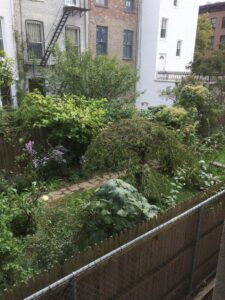 There are so many definitions of an English garden that one frustrated authority boiled them down to this: a garden that looks like it belongs in the British Isles. “Our” English garden consists of three low rising tiers outlined in brick and stone, and a sunken garden. In front: A long narrow lawn framed by cascading bushes and flower beds, the stone bench presiding from the far end. Second tier: a weeping cherry, the garden’s centerpiece, the two espalier apples, and boxwoods. Third tier: a small square lawn, the vegetable patch and apricot tree; and, invisible from the street, a cracked retaining wall and the sunken shade garden.
There are so many definitions of an English garden that one frustrated authority boiled them down to this: a garden that looks like it belongs in the British Isles. “Our” English garden consists of three low rising tiers outlined in brick and stone, and a sunken garden. In front: A long narrow lawn framed by cascading bushes and flower beds, the stone bench presiding from the far end. Second tier: a weeping cherry, the garden’s centerpiece, the two espalier apples, and boxwoods. Third tier: a small square lawn, the vegetable patch and apricot tree; and, invisible from the street, a cracked retaining wall and the sunken shade garden.
I like to think of the retaining wall as a “ha-ha,” that walled drop in a sloping lawn, invisible from the manor, designed to keep game out of the flowers, and so-named because that’s what you say when you nearly fall over it. The ha-ha was a favorite feature of Lancelot “Capability” Brown, who, along with other less memorably named 18th-century English gardeners, transformed the formal garden from a French geometric contrivance to Nature Perfected à l’anglaise, through effusive plantings, architectural follies, orchestrated vistas, and man-made geography, such as serpentine lakes. Our garden is a miniature, sans lake.
It takes up 2,750 square feet, a standard rowhouse lot, plus a dogleg enclosing the oak, which thrusts out of a mysterious mound in the northwest corner of the sunken garden. Based on its eleven-foot circumference, the oak is 254 years old. South Brooklyn was farmland when the progenitor acorn sprouted near the base of the 120-foot Bergen Hill, a glacial moraine. In 1846, when men began carting off the top half of the hill to fill in nearby Red Hook for a port,[1] the tree was eighty years old. They dug around it. Tax photos from 1933 show a tall frame house with a Dutch gambrel roof, gone by 1940. The lot was a junkyard when Nat bought it in 1970 for a few thousand dollars. Today, it’s the only unbuilt private land in Cobble Hill, where brownstones go for north of $6 million.
Nat, raised in Atlanta, attended Phillips Exeter Academy in New Hampshire, and was one of—judging from alumni photos—perhaps two Black men in Harvard’s class of 1955, where he was a protégé of the poet Archibald MacLeish and graduated Phi Beta Kappa. Nat’s story, “Creole Love Song,” was published in The Atlantic when he was twenty-two and included in Best American Short Stories. He won a prestigious Henry Fellowship to study at Cambridge University where he befriended Sylvia Plath. He became an editor and freelance writer.
Christopher came to New York as a young man for a short stay, after training as an accountant in England, and he never left. He worked for a company specializing in furnishings textiles. The garden was his life’s work. 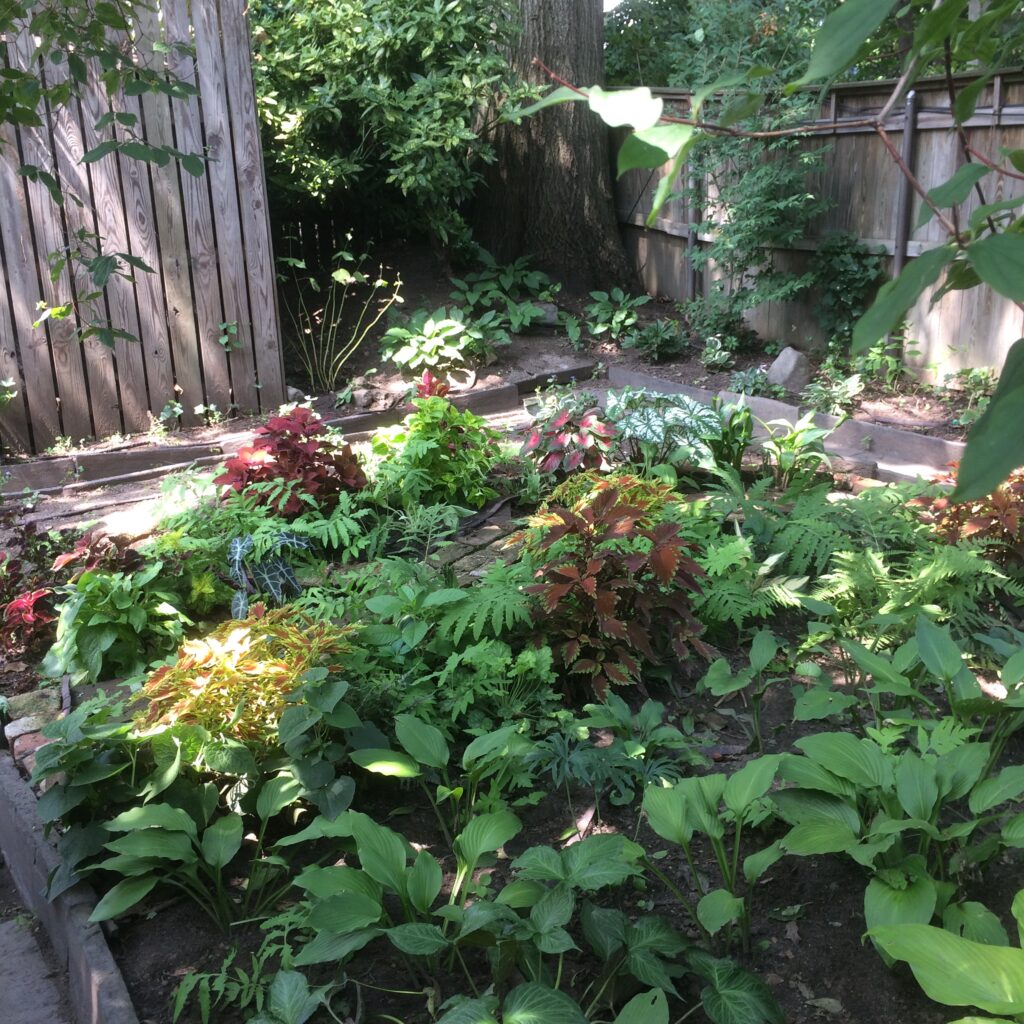
The two men met at the English-Speaking Union, Nat told me once. When they moved to Cobble Hill, the neighborhood was heavily Italian and traditional. Selling to a mixed-race, male couple was controversial, according to Tina, whose family sold Nat his house and warned neighbors to treat the men right or answer to them. Her parents stayed on as Nat’s tenants, and Nat became a friend.
We moved into the church in March 2001 and saw Christopher almost daily on his ladder, clipping the tall euonymous fortunei hedge that separated our properties. But it took a good decade to fully break the ice. My kids annoyed him. I think he thought I was a bad mother. He yelled at me when my son threw a ball into his hedge. “Were you ever a child, Christopher?” I yelled back. Later, my husband and I encountered the couple at a neighbor’s New Year’s open house, where Nat and I bonded over Henry James. Properly introduced, we became friends.
In 2012, Nat and Christopher let us put ladders in the garden to repair our tall stained-glass windows. I wrote and edited on my laptop for several days from Christopher’s stone bench, monitoring the workmen, who, to my horror, crushed plants and broke the fence anyway. Nat wrote me: “…just keep remembering, this has nothing to do with our friendship. It will all come right in the end…We will not be defined by a bunch of ladders and ‘stuff.’ Promise?”
The news Christopher was in the hospital with cancer came in a neighbor’s email in June 2015. I hadn’t seen much of him or Nat that spring, but assumed they were fine. Nat was reclusive by nature. The garden looked perfect. I went round to see Nat immediately on hearing the news, and he told me that Christopher had gone in for a bone marrow transplant. The next afternoon, I found Nat in the garden level of his house, his thin chest cavernous under his t-shirt. “Our friend has left us,” he said, through tears.
There is a strange ugly tension when someone dies, and minds wander from the deceased and the bereaved to their property. A year or so before Christopher died, he and Nat had spoken to me about preserving the garden, but never formalized a plan. Nat didn’t garden. Who would tend it? Would or could any of the people whose yards abutted the garden buy and preserve it? A group of neighbors approached Nat with a plan to transfer the garden to the non-profit Brooklyn-Queens Land Trust. At the last minute, Nat decided to hold on to the property. Not long after, his health deteriorated.
For several years, Larry, a geriatric social worker who generally kept an eye on Nat, and I did our best to keep entropy at bay, but neither of us had the time to maintain the garden to Christopher’s standards. I was afraid it would take over my life, to be honest. Larry’s motto was “What would Christopher do?” We’d imagine him watching us, with horror, resignation, and occasional grudging appreciation.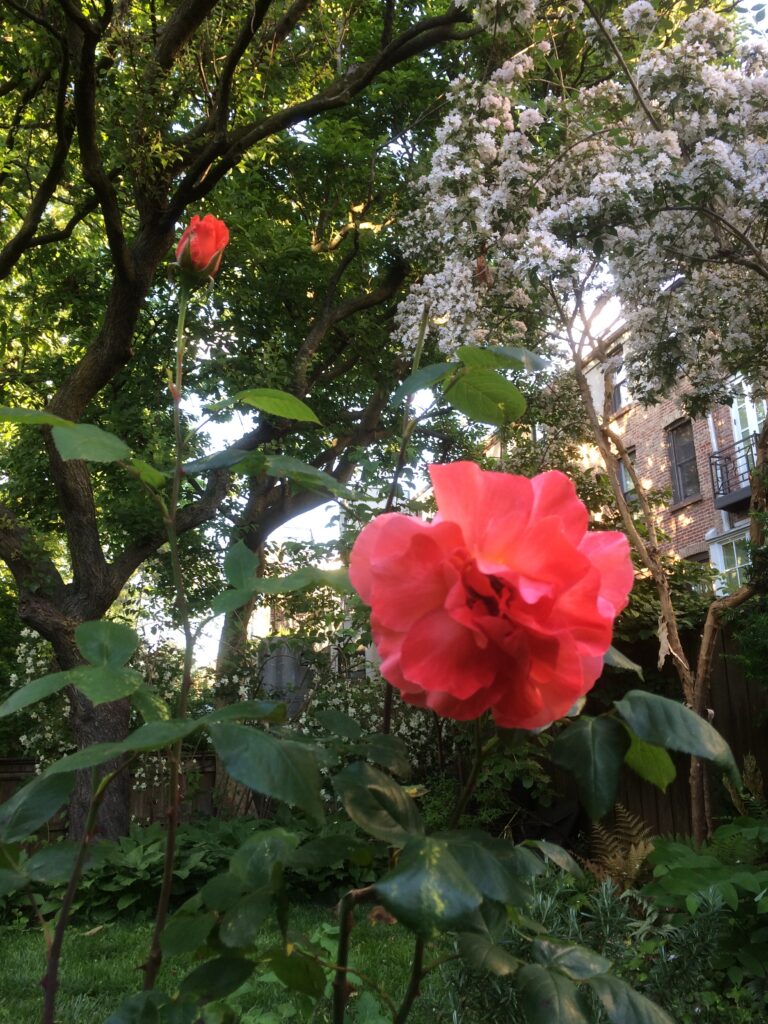
Photos from May 2018 show ankle-high grass and a wildness. The euonymous, an aggressive woody vine which forms sculptural twisted trunks, was overrunning the flower beds. One day, I tore out a fifteen-foot stretch. What would Christopher have said? “Oh, God, I knew this would happen,” was Larry’s joke. In its place, I planted an espalier apple, pruned and shaped to grow flat along a fence or frame, a seventeenth-century French method for growing fruit in small spaces. Christopher liked the bare places filled. I like air and light. Nat told me at some point, “I approve the changes,” winking at my guilty expression, as if to say, “You should have asked, but I forgive you.”
In summer 2019, a utility pole collapsed taking out multiple tree-size bushes. Construction next door left its mark. My friend Courtney’s diligent little boys raked leaves and picked up sticks for hot chocolate and cookies—we’d fill a dozen paper lawn bags and barely make a dent. I began to imagine waking up to see a bulldozer, and it would be my fault because I’d let the garden go, and there was nothing worth saving. Just a weedy, overgrown lot to sell and build on.
As my fellow church-owner and friend, Molly, pointed out, unless I asked for help, people would assume I could maintain the garden myself—to the extent they thought about it. Christopher had, after all, kept it up for fifty years, and lots of people never noticed him. As the garden filled with leaves and winter loomed, I duct-taped a neon-green poster to the gate announcing work days, hoping to rope in a few of the hundreds of passersby. To my surprise, a dozen people showed up. “So, next week?” they said, at the end of the day. So, yes, next week and the next. One Sunday, a young man cleared the sunken garden of vines, leaves, and debris singlehandedly. We dug in peat moss and planted 500 bulbs. Nat’s guardian stopped by and was impressed at the number of bags. “Who knew there was so much trash?” she said.
The first Sunday in March, as the purple Dutch iris pushed through the fallen leaves, we held the inaugural meeting of “Friends of the Secret Garden.” Friday, March 13 was our first work day. Then, New York became the center of the American pandemic. Sirens, empty streets, pages of obituaries. That should have been the end of the “Friends,” but, as newspapers around the world reported, under lockdown everyone wanted to garden. Put me to work, they said. I have a black thumb, but I can follow directions.
Gardening is a basic human instinct. The shovel is a Bronze Age implement. Scissors were invented by the Egyptians. Plants are ferocious competitors, growing, mating, dying, encroaching on each other’s food, space, sun. We create order, keep the peace, decide who survives. We take a break from impotence in the face of the virus, of the would-be despot in the White House, and play god.
The bulbs we planted in the sunken garden produced sweeps of blues and purples, whites and yellows. Ferns, foxgloves, bleeding hearts, and hostas followed, modulating to chartreuse, mauve, pink, dark green. As the dense leaf canopy closed over, we mixed tropical–coleus, colocasia–and temperate shade lovers. The palette slid toward the yellow-red end of the spectrum, a Fauvist play of bright against muted patches.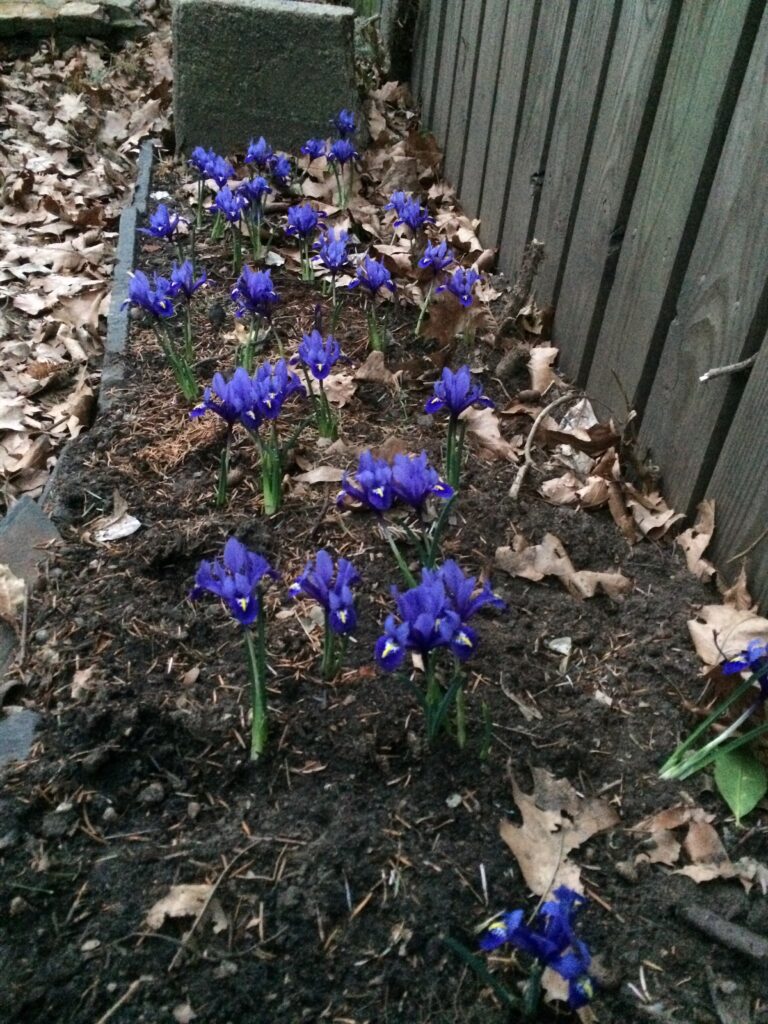
The vegetables we planted for Nat and his caregivers were a small heresy in Christopher’s ornamental scheme. Roses the color of Lucille Ball’s lipstick presided over lettuce and herbs in the spring; tomatoes, eggplants, and peppers in summer; dwindling to pale green and orange tomatoes and shrub-size rosemary. The espalier covered with little apples in May, three varieties grafted onto one trunk, led to ridiculous fantasies of fall apple-picking. After the birds got them, we wised up and covered the fig tree and tomatoes with netting.
In the front of the garden, the part most visible from the street, Fashion Week started in May with cranberry red Weigela, dusky lavender and gold iris, and sagging white viburnum bushes and was still going full swing in late October, as crisp white Montauk daisies offset clouds of asters in gauzy shades of lavender, red hibiscus, and fuscia pearls of callicarpa.
The fern at the gate, which Nat had asked me to preserve, is gone now. There’s too much coming and going. We had to move some old slate slabs that were propped against Nat’s house to hide the bald spot in the lawn.
As its nickname implies, the garden’s mystique has always been its inaccessibility, its English reserve, its noblesse. But the novel The Secret Garden is not just about secrets and walls and the restorative power of gardens. Its deeper message is about prejudice. The protagonist, Mary, arrives from India an imperious little racist to whom people are servants or masters. While gardening and healing, she learns to see character and decency where she’d only seen social status.
Christopher and Nat. Two men, one white, one Black. Pioneers in their era. They put down roots in Brooklyn and planted a garden. The garden takes no political stance. At the same time, one would have to be completely oblivious not to feel a resonance of that story in their garden.
In a city obsessed with real estate, how about an alternate metric to value this particular plot of land? Say a hundred people a day pause to look through the chain-link, that’s 36,500 moments a year. Over the last fifty years, that comes to 1,825,000 moments of peace, mystery, pleasure, surprise. How much is that worth?
Julia Lichtblau’s essays, criticism, and fiction have appeared in American Fiction, The American Scholar, Commonweal, The Common, Blackbird, Narrative, The Florida Review, Superstition Review, The Drum, and elsewhere. She was book review editor of The Common for seven years, taught writing about business and the economy at Drew University, and was a reporter and editor in New York and Paris for BusinessWeek and Dow Jones for 15 years. She has an MFA in Fiction from Bennington College.
Photos by the author.
[1] Gaudet, Connor. “Red Hook History: Leveling Carroll Gardens to Fill in Red Hook.” Star Revue, 1 April, 2015 https://www.star-revue.com/red-hook-history-leveling-carroll-gardens-to-fill-in-red-hook-a-19th-century-project-by-connor-gaudet/




